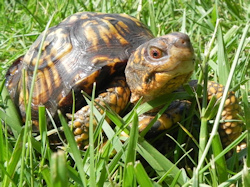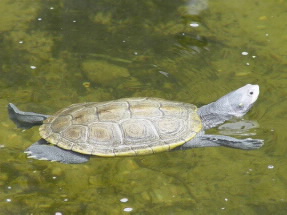|
Diamondback Turtles (Malaclemys terrapin )
|
|---|
|
Below is a basic care sheet
for the Diamondback terrapin (DBT). In New York state it is illegal
to take Diamondback terrapins from the wild. Unfortunately there is
still a period of time in which they may be taken with a permit, but
size guidelines must be followed. You can find these regulations at
the NYS DEC website here:
http://www.dec.ny.gov/regs/
Diamondback terrapins are some of the few turtles that live in brackish water. Brackish water is water that is neither salt water nor fresh water, but somewhere in-between. Many that breed DBT's raise the hatchlings in freshwater and they will grow and thrive in captivity this way. To keep a DBT in brackish water you can buy salt from the pet store that's quite inexpensive, along with a hydrometer to measure the salinity to be sure you are keeping the water at a good level and not too high or too low in salinity. Although captive bred (CB) Diamondbacks can be raised in freshwater, wild caught (WC) turtles should always be kept in brackish or at the very least weaned very slowly to freshwater or you may find shell or skin problems will occur. You can be successful at keeping WC terrapins in freshwater, however what is critical is the cleanliness of the water. PH is also important, it should be alkaline. A good specific gravity (SG) level for WC adults is 1.014 on the hydrometer. When turtles are kept in brackish water they should be given a chance to drink freshwater about once a week. That enables them to take a drink and they will hold that water until they can get a good freshwater drink again. Putting them in a small tote with freshwater will do. I usually keep the water for most hatchlings that come in at around 1.006 since we are not usually sure of their previous history and what kind of water they have been kept in. To get your water started you can use a general guide of one (1) cup of salt to sixteen (16) gallons of water. Let the water circulate well and be sure it’s mixed well before reading the SG. Add more salt or remove water and replace with fresh as needed to get the reading you desire. That measurement will give you the low end of SG so you will likely have to add more salt. A general guide for aquatics is ten gallons per inch of turtle, so never keep a turtle in anything smaller than at least that size. For example if you have a five inch turtle it should have fifty gallons of water to swim in. A bigger area is always better. A good sturdy easy access basking area must be provided for the turtle to get completely out of the water. There should be a basking lamp above this area giving a nice hot basking spot of about 90-95°F. A water heater is not necessary for these turtles. Room temperature is fine or they can live in an outdoor pond where they will get natural sun. They must have a UVB lamp. Providing an all in one mercury vapor bulb like a uv/heat lamp is the simplest way to set up and the most cost effective. One lamp, one fixture. They give off great uvb and great heat. You can set it on a timer and have a good day night cycle. A good varied diet should be provided. Live fish like rosy reds, minnows, etc are usually favored by all DBT’s and there are several good pelleted foods on the market that can help provide some good nutrition. Reptomin, Turtle Brittle and Aqua Max for carnivores are a few good choices. Clams, snails, scallops, shrimp, salmon, smelts and krill are other foods they will usually eat. Variety is key to a healthy turtle. There are a few good
websites with great info on Diamondback care that go into great
detail. Below is a link to help. For excellent supplies for
your turtle with great customer service:
|
All material herein © '2004-2018 "Turtle Rescue of Long Island ". All Rights Reserved









